If you suffer from arthritis in your hands, you know how challenging everyday tasks can become. Simple actions—like buttoning a shirt or holding a mug—can be painful and frustrating. That’s why many people turn to compression gloves, hoping for relief. But do these gloves actually work? Are they worth the investment? In this comprehensive guide, we’ll explore what the research says, how compression gloves work, and answer the most common questions about their use.
What Are Compression Gloves for Arthritis?
Compression gloves, sometimes called arthritis gloves, are specially designed to apply gentle pressure to the hands and fingers. They’re typically made from stretchy, breathable fabrics like nylon, Lycra, cotton, or neoprene, and often feature an open-finger design to allow for dexterity
How Do Compression Gloves Work?
The primary goals of compression gloves are:
-
Reducing Swelling: The gentle pressure helps push excess fluid out of the hands, reducing swelling.
-
Easing Pain and Stiffness: Compression and warmth can help soothe painful joints and improve flexibility.
-
Supporting Joints: The gloves provide light support, which can make movements less painful and more controlled.
Some gloves are also infused with copper or designed to provide extra warmth, which some users find soothing.
What Does the Research Say?
Several studies have examined the effectiveness of compression gloves for arthritis:
-
Pain Relief: Most studies show that wearing compression gloves can reduce pain and stiffness, especially when worn overnight. However, the improvements are often modest.
-
Warmth vs. Compression: Recent research suggests that much of the benefit may come from the warmth and comfort of the gloves, not just the pressure. In a clinical trial, both snug compression gloves and looser, non-compressive gloves provided similar relief, indicating that warmth and support may be as important as compression itself.
-
Function: While some people notice improved hand function, the effects are generally small.
“On average, neither type of glove made a big difference to hand symptoms and hand function. Although participants in both groups reported positive effects after wearing the gloves, these improvements are likely a result of the added warmth and feeling of support they felt.
Are Compression Gloves Worth It?
Compression gloves are commonly prescribed by doctors and occupational therapists for people with rheumatoid arthritis or undifferentiated inflammatory arthritis8. Many users report feeling more comfortable and able to do daily activities with less pain and stiffness, especially in the morning.
Common Questions About Compression Gloves
Should You Sleep with Compression Gloves On?
Yes, many people wear compression gloves overnight to reduce morning stiffness and pain. Start by wearing them during the day for short periods to get used to the sensation, then try overnight wear if comfortable.
What Size Compression Gloves Do I Need?
Measure the circumference of your hand at the knuckles (excluding the thumb) and refer to the manufacturer’s sizing chart for the best fit. Gloves should feel snug but not too tight—if they leave marks or cause numbness, try a larger size.
How Long Can You Safely Wear Compression Gloves?
It’s generally safe to wear compression gloves for several hours at a time, including overnight. However, do not wear them 24/7, as this can affect skin hygiene and comfort. Take breaks, and always ensure your hands are clean and dry before putting them on.
Are Heated or Copper-Infused Gloves Better?
Heated gloves can provide extra warmth, which some users find especially soothing. Copper-infused gloves claim to have additional benefits, but there’s little scientific evidence that copper itself makes a difference beyond the effects of compression and warmth.
Tips for Getting the Most Out of Compression Gloves
-
Choose the Right Material: Look for breathable, moisture-wicking fabrics to keep your hands comfortable.
-
Start Slowly: Wear the gloves for short periods and gradually increase as you get used to them.
-
Keep Them Clean: Wash your gloves regularly to maintain hygiene and prevent skin irritation.
-
Replace When Needed: Compression gloves stretch out over time and should be replaced every 4–6 months or when they become loose.
When Should You Avoid Compression Gloves?
-
If you have open wounds, skin infections, or severe circulation problems, consult a doctor before using compression gloves.
-
Do not wear gloves while driving, as they may affect your grip.
Final Thoughts
Compression gloves aren’t a miracle cure, but for many people with arthritis, they offer gentle relief from pain, swelling, and stiffness—especially when combined with other treatments like medication, exercise, and joint protection. Whether you choose a snug compression glove or a looser, warming glove, the key is finding what feels best for your hands and fits your lifestyle.

